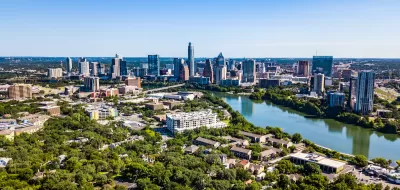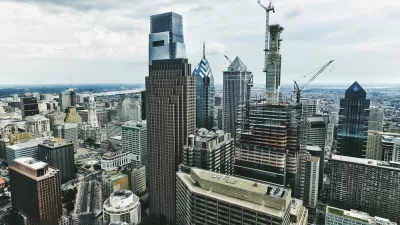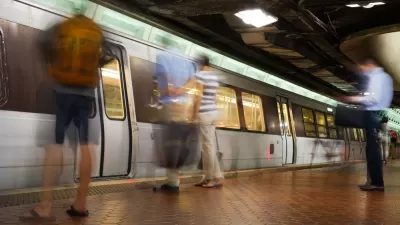With housing and transportation as the two biggest sources of carbon emissions, a new report shows how boosting density near transit would accelerate emissions reductions.

A report from the nonprofit Transit Forward indicates how Austin could meet its transportation and climate goals by supporting increased housing density, reports Nina Hernandez in Austin Monitor. “The report includes climate projections for Austin and then outlines how housing density and transit can help ease those impacts by reducing greenhouse gas emissions.”
The report notes that “the average carbon footprint for a single-family household is 100 pounds of CO2 per square meter. Dense housing units closer to the city center have lower carbon footprints.” On a map showing carbon footprints by neighborhood, the University of Texas’ West Campus numbers among the areas with the lowest average footprint. In the United States, college campuses are one rare example of walkable, mixed-use communities with dense housing and plenty of opportunities to access daily needs without a car.
The report’s recommendations include increasing housing density coupled with access to mobility and boosting local transit systems. According to Bill McCamley, executive director of Transit Forward, “We need more transit and we need more dense housing near transit because housing and transit combined, they’re number one and number two in terms of greenhouse gas emissions.”
FULL STORY: Report suggests Austin reach net-zero climate goals via housing density and increased transit

Maui's Vacation Rental Debate Turns Ugly
Verbal attacks, misinformation campaigns and fistfights plague a high-stakes debate to convert thousands of vacation rentals into long-term housing.

Planetizen Federal Action Tracker
A weekly monitor of how Trump’s orders and actions are impacting planners and planning in America.

In Urban Planning, AI Prompting Could be the New Design Thinking
Creativity has long been key to great urban design. What if we see AI as our new creative partner?

Sean Duffy Targets Rainbow Crosswalks in Road Safety Efforts
Despite evidence that colorful crosswalks actually improve intersection safety — and the lack of almost any crosswalks at all on the nation’s most dangerous arterial roads — U.S. Transportation Secretary Duffy is calling on states to remove them.

‘Architectural Epidemiology:’ Centering Public Health in Urban Design
A new book asks, what if cities were designed around health equity?

Study: London Low-Traffic Neighborhoods See 35% Drop in Road Injuries
London’s effort to reduce speeds and limit vehicles in parts of the city are contributing to improved road safety.
Urban Design for Planners 1: Software Tools
This six-course series explores essential urban design concepts using open source software and equips planners with the tools they need to participate fully in the urban design process.
Planning for Universal Design
Learn the tools for implementing Universal Design in planning regulations.
Gallatin County Department of Planning & Community Development
Heyer Gruel & Associates PA
JM Goldson LLC
Mpact (founded as Rail~Volution)
City of Camden Redevelopment Agency
City of Astoria
City of Laramie
Jefferson Parish Government
Camden Redevelopment Agency





























